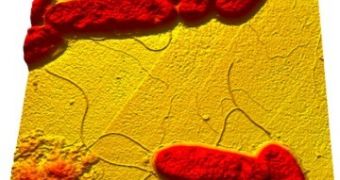It's not the first time scientists hear about Shewanella bacterium and something tells me it's not gonna be the last time neither. We know certain types of bacteria are capable of producing electric energy just through feeding, however this is the first time when University of Minnesota researchers reveal the processes which take place during this conversion. During their study, the researching team found out that the Shewanella bacterium is able to process waste material directly into electricity, with the help of a riboflavin produced by it.
It is important to note that the Shewanella bacterium can only be found in the frigid waters of the Arctic and Antarctica. Previously, the Shewanella bacterium was successfully used in nanotechnology for the building of nanowires and in the nuclear energy field as a cleaning agent for uranium waste. The featured image is an AFM topograph of Shewanella oneidensis bacterium during a metal reducing stage, while being placed under an electron acceptor limitation, a device that stimulates it to produce a conductive medium through which electric energy can flow.
The study was conducted by assistant professor Daniel Bond from the University of Minnesota's Department of Microbiology. Bacteria are well know for their ability to direct electrons to metals and manipulate them in ways that can change their chemistry. In fact, Shewanella can dissolve metals, such as iron, relatively easily.
Bacteria able to catalyze electron exchange between different metals are usually the primary agents in metal cycling, and can be successfully used in remediation processes. Curiously, bacteria are so good at their job that they were even used in fuel cell research as conductive surfaces for fuel cell membranes or other applications that imply the use of special conductive surfaces. The technique used by the University of Minnesota researchers involved a Shewanella oneidensis MR-1 biofilm and a Shewanella sp. Alternatively, a MR-4 film was grown electric stimulation techniques. The biofilms catalyze the redox reaction within the mass of substance, generating small amounts of electricity in the process.

 14 DAY TRIAL //
14 DAY TRIAL //